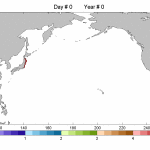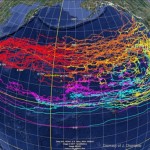My marine debris buddy Nick Mallos of Ocean Conservancy pointed me to this beautiful animated model by Nikolai Maximenko and Jan Hafner of the University of Hawaii. This animation shows how wind affects the rate at which debris from the Japanese tsunami moves across the Pacific. It is a mathematical model that incorporates a great deal of ocean data, like ocean current and wind speed, but is not a direct measurement of actual debris pieces. First take a look at the prettiness, then scroll down for an explanation.
Objects that float mostly above the surface of the water, like chunks of styrofoam, are more affected by the speed of the wind than the speed of the water, so they scud quickly across the ocean surface. This means they have “high windage,” and are shown by the red dots in the model. Objects that float half-in, half-out of the water, like fishing buoys and containers, have medium windage and move somewhat faster than the water (green dots). Objects that don’t float above the surface of the water, like fishing nets and plastic crates, have low windage and move the same speed the water (purple dots).
This explains why debris objects appear to be showing up earlier than scientists originally expected – high windage objects such as the dock found in Oregon and the soccer ball found in Alaska moved relatively quickly across the ocean.
Many thanks to Nick for answering my questions over Twitter, and for Nikolai & Jan for making their model publicly available.







Did Maximenko and Hafner make any use of James Ingraham & Dr. Curtis Ebbesmeyer’s exhaustive OSCURS work? Though I’ve been critical of how much they relied on it, they made their own graphs & information (though no cool animation) on tsunami windage publicly available back in December/January. Much of their analysis & prediction proved true (though again, with caveats). It seems appropriate that they get credit as well. http://beachcombersalert.blogspot.com/2012/01/tsunami-debris-arrives-in-america.html
OSCURS and SCUD are different models, though I’m afraid I don’t know specifically how they differ.